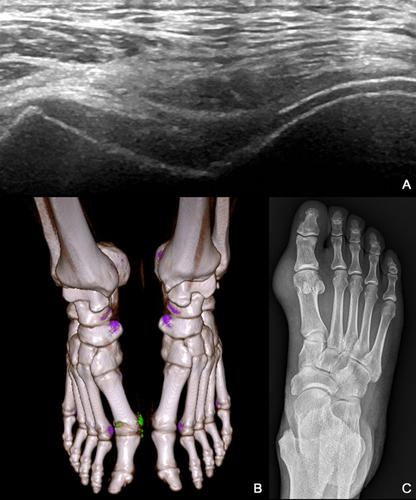Scientific Reports ( IF 3.8 ) Pub Date : 2023-08-02 , DOI: 10.1038/s41598-023-39508-5 Tzu-Min Lin , Hsiang-Yen Lee , Ching-Kuei Chang , Ke-Hung Lin , Chi-Ching Chang , Bing-Fei Wu , Syu-Jyun Peng

|
Gout is a common metabolic disorder characterized by deposits of monosodium urate monohydrate crystals (tophi) in soft tissue, triggering intense and acute arthritis with intolerable pain as well as articular and periarticular inflammation. Tophi can also promote chronic inflammatory and erosive arthritis. 2015 ACR/EULAR Gout Classification criteria include clinical, laboratory, and imaging findings, where cases of gout are indicated by a threshold score of ≥ 8. Some imaging-related findings, such as a double contour sign in ultrasound, urate in dual-energy computed tomography, or radiographic gout-related erosion, generate a score of up to 4. Clearly, the diagnosis of gout is largely assisted by imaging findings; however, dual-energy computed tomography is expensive and exposes the patient to high levels of radiation. Although musculoskeletal ultrasound is non-invasive and inexpensive, the reliability of the results depends on expert experience. In the current study, we applied transfer learning to train a convolutional neural network for the identification of tophi in ultrasound images. The accuracy of predictions varied with the convolutional neural network model, as follows: InceptionV3 (0.871 ± 0.020), ResNet101 (0.913 ± 0.015), and VGG19 (0.918 ± 0.020). The sensitivity was as follows: InceptionV3 (0.507 ± 0.060), ResNet101 (0.680 ± 0.056), and VGG19 (0.747 ± 0.056). The precision was as follows: InceptionV3 (0.767 ± 0.091), ResNet101 (0.863 ± 0.098), and VGG19 (0.825 ± 0.062). Our results demonstrate that it is possible to retrain deep convolutional neural networks to identify the patterns of tophi in ultrasound images with a high degree of accuracy.
中文翻译:

基于迁移学习和临床实践的超声影像痛风石识别
痛风是一种常见的代谢性疾病,其特征是软组织中沉积一水尿酸钠晶体(痛风石),引发强烈和急性关节炎,伴有难以忍受的疼痛以及关节和关节周围炎症。痛风石还可促进慢性炎症和糜烂性关节炎。2015 ACR/EULAR 痛风分类标准包括临床、实验室和影像学表现,其中阈值评分 ≥ 8 表示痛风病例。一些影像学相关表现,例如超声中的双轮廓征、双能中的尿酸盐计算机断层扫描(或放射线照相痛风相关糜烂)的得分高达 4 分。显然,痛风的诊断在很大程度上需要影像学检查的帮助;然而,双能计算机断层扫描价格昂贵,并且使患者暴露在高水平的辐射下。尽管肌肉骨骼超声是非侵入性且廉价的,但结果的可靠性取决于专家的经验。在当前的研究中,我们应用迁移学习来训练卷积神经网络,以识别超声图像中的痛风石。预测精度随卷积神经网络模型的不同而变化,如下:InceptionV3(0.871±0.020)、ResNet101(0.913±0.015)和VGG19(0.918±0.020)。灵敏度如下:InceptionV3(0.507±0.060)、ResNet101(0.680±0.056)和VGG19(0.747±0.056)。精度如下:InceptionV3(0.767±0.091)、ResNet101(0.863±0.098)和VGG19(0.825±0.062)。我们的结果表明,重新训练深度卷积神经网络以高精度识别超声图像中的痛风石模式是可能的。






























 京公网安备 11010802027423号
京公网安备 11010802027423号